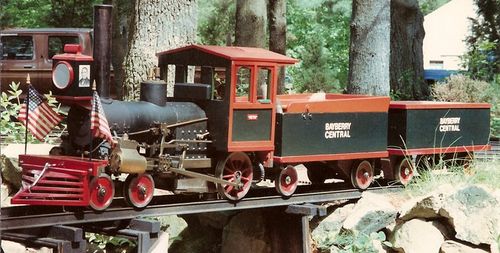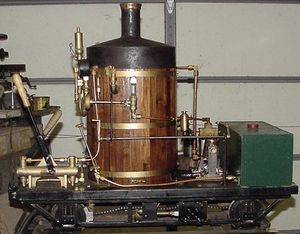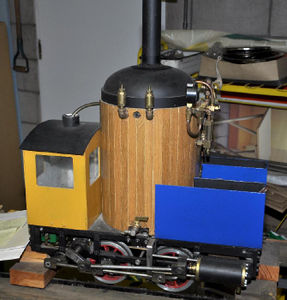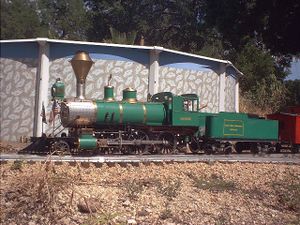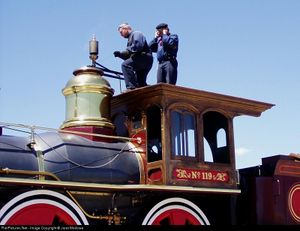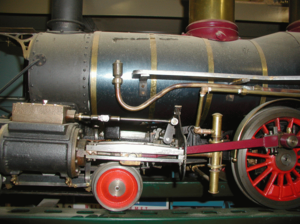Lagging
Lagging is a covering placed over the boiler and serves three purposes:
- Reduce heat loss from the boiler
- Provide a cooler external surface to reduce the chance of burns to humans and equipment
- Provide an improved aesthetic look to the boiler and locomotive
Definition
Boiler Lagging, from Wikipedia
Large amounts of heat are wasted if a boiler is not insulated. Early locomotives used shaped wooden battens fitted lengthways along the boiler barrel and held in place by metal bands. Improved insulating methods included: applying a thick paste containing a porous mineral, such as kieselgur, or shaped blocks of insulating compound such as magnesia blocks[19] were attached. In the latter days of steam, "mattresses" of stitched asbestos cloth were fixed stuffed with asbestos fiber (but on separators so as not quite to touch the boiler); however in most countries, asbestos is nowadays banned for health reasons. The most common modern day material is glass wool, or wrappings of aluminum foil.
The lagging is protected by a close-fitted sheet-metal casing[20] known as boiler clothing or cleading.
- From Eureka Encyclopedia:
- To reduce heat loss boilers are insulated and then covered with a thin steel sheathing. At first, locomotive boilers were usually insulated with wood battens secured by hoops and varnished. Fireboxes were left bare at first but, from 1839 some were covered, either over the lower part or totally. A layer of felt was sometimes added under the wood but this got wet in the rain and, from 1847 there was a gradual introduction of sheet iron covering in place of wood. From about 1900 asbestos was used and this remained until its use was rendered illegal in most countries and various forms of wool waste or felt were again adopted.
From Chaski.org:
- Question: Whats the difference between a boiler jacket and boiler lagging?
- Answer: Lagging is the boiler's insulation. The jacket is the cover for the boiler and insulation. Think of a house or other building. Where insulation has been installed on it's frame and is then covered by wood, stucco, or brick.
Insulation Necessary?
- There have been several studies done that show that cladding by itself is fairly effective in cutting down heat loss from a boiler (reported in Model Engineer at various times over the years). Insulation adds to that, but not as much as the cladding.
- When you think about it, the function of any insulation (at the temperatures in question) is to trap a layer of air and keep it from moving away from the boiler surface. The cladding by itself does that fairly effectively. Any insulation you might add should be light since its only function is to prevent air movement. A heavy, dense or tightly packed insulation would tend to transmit heat by conduction which defeats the purpose. A polished surface radiates less heat, that's why metal teapots or coffee pots are highly reflective (besides the fact that it looks nice), but painted surfaces are probably not as effective, because their colour will look quite different in the infrared heat range.
- After all, the 3 methods of heat transfer are: conduction, convection and radiation. Radiation varies as the fourth power of the Absolute temperature (Rankine or Kelvin) so at any temperatures much below a red heat, its contribution is negligible by comparison with the other two. Inside the firebox, it is the major contributor because of the radiant heat from the coal bed.
- Tests by live steamers have indicated (although inconclusively) that insulation is of negligible value as an economizer either in improved steaming or fuel savings on live steam locos although it does appear to make some difference in the external jacket temperature. Several materials, including a simple air space, have been used over the years, all with advantages and drawbacks. Fiberglass, wool felt, sheet cork, ceramic cloth, balsa wood and others have all been tried with approximately equal results. One factor that is often a consideration is moisture retention, the tendency of the material to trap and retain moisture between the jacket and boiler, particularly if either one of those is steel. My current choice of insulation material is called Fiberfrax, an inert ceramic cloth material capable of withstanding up to around 1900°F and available in several thicknesses.
From The Live Steamer, May-June 1951
- It is only necessary to fully lag a small locomotive in winter. In climates such as Great Britain, where it does not do go much below freezing point, a thin sheetmetal clading to hide the stayheads in the firebox wrapper, is ample. The barrel can go naked and unashamed provided it isn't ornamented with blobs of brazing material or other unsightly excrescences. The above is all my 30 year old 2-1/2 inch gauge locomotive "Ayesha" has; and when running in falling snow against a biting north wind, all she needed to keep the pops busy, was an extra shovelful of coal. Naturally, a lot depends on the design of the boiler. Certain designs I know of wouldn't steam in -- well, you can guess where!
- In regards to the question of "lagging boilers", my position is that it resolves itself around the relative merits of a small lagged boiler versus a larger unlagged boiler. Thus a locomotive that requires a boiler 5 inch diameter that is lagged so that the result is a 5-1/2 inch or 6 inch diameter over the lagging, why not use the larger diameter for the boiler proper in the first place? To my mind, the resulting boiler will be easier to manage on account of its larger firebox, water capacity and steam space. To me this is more desirable than the last ounce in efficiency. I might also mention that most of L.B.S.C. boilers are not lagged. For that matter neither are mine, and I now have four, of which only one is lagged. That was the first one I built some 25 years ago.
Lagging
Wool
- Harry writes:
- You don't see this done much but once many years ago someone suggested to me that wool felts would make a good insulator for model boilers. I tried it and it works great. It's relatively thin and a great insulator. You must be sure however that it's wool felt and not a synthetic, which is what you will find at most local cloth & sewing shops. Wool felts are available in many thicknesses and densities/weights. I use 1/8" for larger boilers and 1/16" for smaller ones. There is no problem with saturation. Since it "breathes" through the fibers, any water that might find its way to the fabric gets baked out during steaming.
Kaowool Cerablanket
- A&K Locomotive posted the following on eBay:
- In regards to live steam boiler Insulation for protection of steel boilers heat loss. We have found that Kaowool Blanket will result in optimum protection of heat loss for steel boilers. If you are using a insulating material such as the Calcium Block when it gets wet it is very hard to dry out in most cases and holds moisture against the outside boiler steel.
Fiberglass
- Rich Carlstedt writes:
- Fibre Glass Matting like used on Boats or Auto repair. Not the thin stuff, but 1/8"+ thickness.
- Robert Williams writes:
- Check the McMaster-Carr online catalog. They have several nice products for the insulation of pipes and tubing. It resembles in a very big way the products offered by the Steamfitter and may have the same origin. The nice thing is they will sell you a foot of the material or a entire roll.
- Bruce Mowbray writes:
- In building my 1 1/2" scale locomotives, I use alternating layers of heavy duty aluminum foil from the supermarket and woven fiberglass cloth material from marine suppliers. Usually 5 layers of the cloth and 6 of foil. The foil helps to reflect the heat back into the boiler and the gass has insulating value. I make cardboard patterns and cut the materials to size. I use staples to make a seam along the edgeof the panels. The layers of foil help the sandwiches stay in place but I use thin wire to hold them in place until I get the outer wrapper on. This method does not tend to crumble when handled and is easy to remove and replace as needed.
- Dick Patton writes:
- I am using a high temp heat resistant product used by the hot rod group to insulate exhaust headers on their engines. It comes in rolls with the material being about 2 inches wide and 1/16th of an inch thick. The stuff is tough, woven fiberglass, not fluffy, and won't tear as you wrap it around pipes (or boiler shells), and has to be cut with scissors. The advantage is that you can keep wrapping and overlapping until the thickness wanted is achieved, with no templates needed. I have been using it to wrap the insulation on the steam lines on one of the NCNGRR Museum's steam locomotives.
Fiberfrax
- Fiberfrax
- A new material made from washed ceramic fibers with binders added to form a lightweight, flexible asbestos-free insulation. Withstands temperatures to 2300 F. Excellent for aircraft firewalls. Available in 24" wide. Sold by the foot.
- High Temp Coating
- Used as a hi temp coating over Fiberfrax, or other pourus materials. Can also be used as an adhesive to bond Fiberfrax or other pourus material together.
- Jonathan Hollahan writes on live_steamer@yahoo.com:
- I used two layers of 1/8". The stuff is fairly fragile, tears easily, and doesn't like masking tape. I used stainless steel wire to hold it in place until the jacket was installed.
- Bill Shields writes:
- I have been using Fiberfrax for years, very happy with it.
Felt
- Pat Fahey writes:
- On my 3/4" scale boilers I was using felt fabric, the cheapest that I could find, for insulation. It was easy to work with, and cut to fit around the boiler. As for the boiler jacket, yes it was stovepipe that was primed and painted.
Wood
- UnkaJesse writes:
- I insulate all of my boilers whether it visibly helps or not. I realize that 1/8 " of insulation beneath my jacketing ain't much, but common sense says it does help a teeny tiny amount. On the "Newbie Project" locomotive as featured in Live Steam magazine, I used 5/16" thick American Black Walnut both for its insulation and appearance. One can touch the walnut lagging briefly and get nary a burn, but on the locomotive boilers with 1/8", the touch must be very brief so I know it is not helping as much as the thicker wood. Of course the rate of heat transfer to a person's skin is much faster with steel jacketing over insulation than is the case with wood.
- Robert Williams writes:
- Teak wood is extremely resistant to decay and moisture since it contains a high amount of natural oil. This is why is so favored for use in sailing vessels and deck material on battleships. I am sure it would be an excellent choice for lagging your boiler. Wood was one of the first natural insulators used for boilers many years ago and still works well today. Honduran Mahogany would also be a good choice as it has the lowest shrinkage expansion ratio of any commercial hardwood known to man. It is also very easy to work and can be downright beautiful if finished properly.
- Gordon French wrote on lshobbyists@yahoogroups.com:
- No one has mentioned Balsa wood (think model air planes) but it does work, its readily available, cheap, and is easy to apply. Some old models were lagged with wood, some beautifully so. I would use less than 1/4 inch thickness just for the workability.
Cork
- RichD writes:
- On my Tenwheeler and Wren NG I will be using over the zinc phosphate primered and hi temp manifold painted boiler, a single layer of ceramic paper and then a layer of 1/8" cork. The cork will slightly char at 125 psi temps (actual test case), so the ceramic paper will protect it. Not much insulation value for sure, but I want support for the jacket. A layer of aluminum foil, shiny side in, against the boiler will help as well. For jacket material use pre prep (primered) steel sheet if you can find it.
- Paul writes:
- I have used cork floor tiles which work well. A good few coats of paint on the boiler. Wrap some double sided tape around the boiler. Then cut the floor tiles into 1" wide strips. You can then stick the strips to the boiler and make up the thickness as required. I have found that additional tape around the outside is then good enough to hold it all together until you fit the lagging.
- John Greiner writes:
- I used 1/8" cork sheet on my Allen Mogul. This works good because it is waterproof and does not yield, yet is flexible and easy to work with.
- Phil writes:
- I have used both Ceramic fibre sheet (similar to Fibrefrax, but in 3mm sheet - 2 layers compressed down to 3mm) and 3mm cork sheeting. I'm sorry to say that the cork gave me a lower wrapper temp than the ceramic fibre, and I only had the odd spot of surface rust on the boiler barrel after 8 years. I don't know if I'll have more or less rust when I one day remove the ceramic fibre insulation.
Asbestos
Asbestos was commonly used on model steam locomotives constructed prior to the 1970's when the extreme danger of the material was discovered. DO NOT use asbestos on new builds. If you work on an older steam locomotive take the necessary steps required for asbestos abatement.
See Asbestos lagging at Chaski.org.
- A&K Locomotive posted the following on eBay:
- In restoring any older boiler that contains asbestos you should abate that material as soon as possiable by a Licensed Professional. There was a local guy who did his own abatement with out permits, inspections or air testing himself a few months ago. He and his buddy got a couple years in Club Fed on the Tax payers dime. Just something you should consider in buying any older steam boiler in restoration costs down the road.
Air
- crew writes:
- I do have an air gap between the boiler shell and the jacket and it does not get so hot that burns you. Yes it is hot but i can touch it with out damaging my skin. 20 gauge steel works well, I did not paint the inside. and I don't have a rust problem after ten years. This could be because of the air gap.
Automotive Header Manifold Blanket
- FriscoJim writes:
- I've used header blankets with good results
Cladding
- From Chaski.org:
- Prototype loco (and stationary) boilers used banding to keep the jacket material in place. Look at a picture of an "old time" loco. The brass strips you see are the jacket bands. On "old time" loco's, the banding is more noticeable as it was polished brass, where on modern loco's the banding is painted black or the color of the jacket.
Steel
- crew writes:
- I am using 20 gauge steel on my American, the jacket is now 10 years old. I did not lag the boiler as I did not like the idea of it not allowing water to freely run off and dry form the heat of the boiler or air. I do have an air gap between the boiler shell and the jacket and it does not get so hot that burns you. Yes it is hot but i can touch it with out damaging my skin. 20 gauge steel works well, I did not paint the inside. and I don't have a rust problem after ten years. This could be because of the air gap.
- Wayne Davis used the steel sheet metal cladding from a discarded water heater on his scratch built 0-4-0. It has been in operation well over 10 years with no problems with the cladding.
Galvanized Steel
- GWRdriver writes:
- Galvanized steel has a naturally "oily" surface and the old way of prepping galvanized material (like gutters) is to first to scrub it well with hot detergent and rinse. Then etch it with household vinegar, apply until it acquires a frosty patina. Kill the etch off with a soda water (or baking soda) and rinse well. I then use one coat of automotive self-etch primer, then paint of choice.
- RichD wrote:
- I owned an engine with a galv duct metal jacket that would not retain it's paint after two attempts. Stripping and coating with zinc chromate (now zinc phosphate) primer then top color coat and now over ten years old is still like new.
Stainless Steel
- Bill Shields writes:
- Stainless steel shim stock makes good wrapping. Holds paint well and will not corrode. Replacing some now on a old loco because has a new boiler that old wrapper will not fit. Wrapper looks like new (40+ yrs old) on the inside. It also conducts heat a lot less than steel, so is a 'radiant wrapper' of sort.
Blued Stove Pipe
- Lovesthedrive writes:
- You might consider going to a stove shop. Some of them still sell blued pipe.
- Charles Pipes writes:
- Another advantage to this is that you can ask for a heavier gauge piece of steel than the pipe would normally come in. I used a shop here in Huntsville to roll 18 gauge sheets for a small beer keg furnace. When they found out what I needed it for they even spot welded my seam at no extra charge. Another plus if you lay out your whole pattern on paper you can transfer prior to having them roll it.
- Dick Morris writes:
- The boiler jacket on this very dirty CP-173 is blued stove pipe. After bending and fitting it there were some scratches and I knew it would be prone to rust. I then found some auto touch-up paint for an older GM vehicle which is a fairly close match.
Steam Pipe Lagging
- I use strips of something called interfacing that I obtained from my wife's needlework box. I cut it into half inch wide strips, and wind it round the pipes. It moulds round the bends quite nicely if it is not too wide, and tends to cling to itself. When enough has been applied, I wind a length of thick cotton around it, with about a one eighth inch pitch (at 1/12 scale), and secure it. I then paint it with white artists' acrylic paint.
- Daris A Nevil writes:
- Try cotton tennis shoe strings. I found some long (24 inch) black shoe strings. Wrapped them tightly around the steam piping, then wound 20 gauge copper wire at each end to keep the shoe string from unraveling. Brushed on spar (marine) varnish to "glue" everything in place. Looks very nice.
